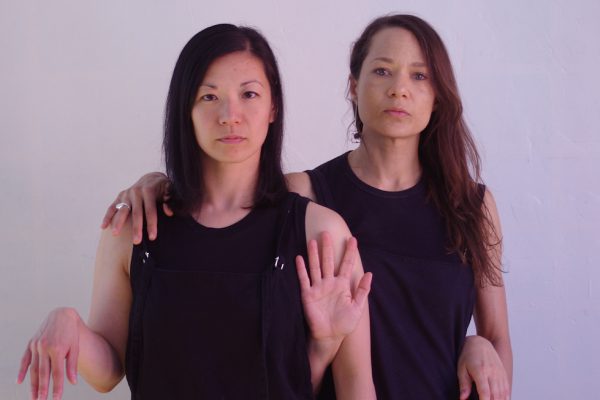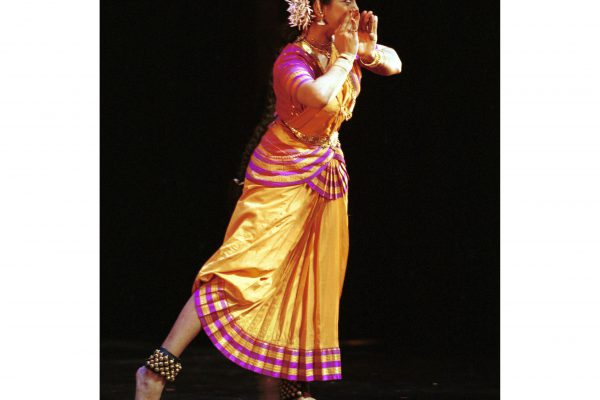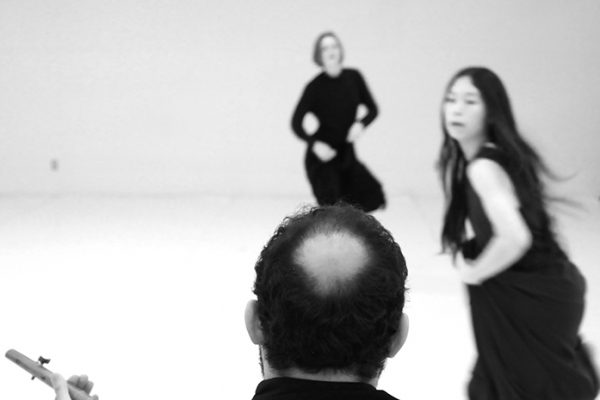Every flamenco show needs at least one inspired soloist, a bailaora (flamenco dancer) who sets the audience’s pulse beating faster. Kasandra, the lead dancer of Mozaico Flamenco Dance Theatre, was certainly that during the company’s one-night only premiere of “Café de Chinitas” at the Norman Rothstein Theatre. Kasandra was also the show’s originator, director and principal choreographer.
“Café de Chinitas” takes its title from a 19th-century café in Malaga, Spain, where famous flamenco artists performed, and which was popular with Asian women, known as “chinitas.” Other flamenco shows have used the same title, but what makes Mozaico Flamenco’s version stand out is the Asian touch that Kasandra, a second generation Chinese-Canadian, gave to it.
Kasandra chose as her musical collaborators a top Vancouver trio, the Orchid Ensemble. The group mixes traditional Chinese stringed instruments — the erhu, which is like a violin, and the zheng, a type of zither — with Western percussion. During “Café de Chinitas”, a traditional flamenco guitarist and, occasionally, a cellist joined the trio. The music was fabulous — lively and nuanced — especially when guest artist Keiko Ooka, a Japanese-born flamenco singer based in Madrid, joined them. Ooka’s vocals had that haunting wail so beloved of flamenco singers and, with her long dark hair, black pants and jacket, and sturdy heeled shoes, she looked absolutely, well, Spanish.
Not that anybody was trying to pass. The Orient was key to the work, as was evident in the title, the music and, also, the costuming. For one number called Lantern Riddles the ensemble wore long red Chinese dresses with thigh-high slits, with five dancers carrying fans and one, an umbrella. Unfortunately, the choreography was disappointing; Kasandra punctuated what was essentially a flamenco fan dance with a stereotypically Chinese style of movement — small steps and pertly angled heads. Although the audience chuckled in amusement, it looked clichéd.
The opening number was also costumed Asian-style with the ensemble in long black skirts and embroidered black satin tops. Choreographed by Oscar Nieto, who founded Mozaico Flamenco more than thirty years ago and remains its artistic director, the dance was set to a song called Café de Chinitas by the great Spanish poet Federico Garcia Lorca. The scenario was promising in terms of passion — glamorous women, a proud, haughty man checking them out — but guest artist Pablo Pizano failed to ignite any flames between himself and the Mozaico Flamenco company members, though they smouldered hopefully. Pizano, who favoured a disheveled appearance and is somewhat stolid in style, kept his distance from the audience as well.
The only other male dancer was fifty-nine-year-old Nieto, who performed a gentle solo that added a welcome dose of maturity to the evening. Though a little stiff and emotionally distant, he was still a strong, masterly presence.
“Café de Chinitas” as a whole, however, plodded predictably along, taking the familiar flamenco form of alternating the ensemble with a soloist. The structure might not have felt so stale if Kasandra’s choreography had been fresher. Dancing mostly in unison, the ensemble became a wash of sinuous arms and hands, proud backs and stamping feet, unable to surpass the need to hit their marks and remain together. It was the numbers that were improvised within flamenco’s loose structures that were the most dynamic: Nieto’s solo and Kasandra’s two solos.
Particularly in the first one, Kasandra was a knockout. Resplendent in an orange dress with matching shoes, her hair long and curled, her performance was a triumph of character and form. Kasandra’s persona on stage is always spunky but this time she added a note of sunny seduction that left the audience in an uproar. Instead of the typical flamenco hauteur and angst, she dared present a woman who was happy and strong. In absolute control despite the most flamboyant strutting and turning and posing and pounding, Kasandra was never for a moment less than brilliantly graceful. That exuberant, flexed-foot skipping that flamenco dancers do — a step Kasandra is fond of — was saved for the ending, when it seemed like she leapt great distances and great heights. I must be exaggerating, but what I am sure of is that it was a real treat to watch such an imaginative and inspired bailaora.
It should be noted that the company’s multiculturalism goes beyond Kasandra’s Chinese roots. As Nieto states in the program, Mozaico Flamenco reflects the diversity of its Vancouver base. Nieto himself was born in the United States and is of Mexican heritage; other dancers have roots in England and the Philippines. One dancer was born in Spain, but grew up in Winnipeg.
Though “Café de Chinitas” was a long show, and might have made a more satisfying hour, something it did wonderfully well was to prove — through performers like Kasandra, Nieto and Ooka — that true flamenco spirit does not belong only to Spaniards and gypsies. It’s all in the artistry.
Tagged: Flamenco, Performance, BC





